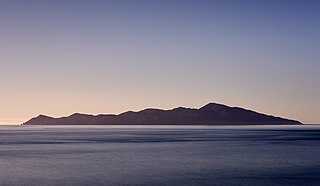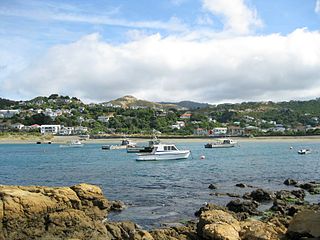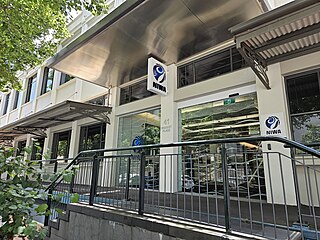Victoria University of Wellington is a public research university in Wellington, New Zealand. It was established in 1897 by Act of Parliament, and was a constituent college of the University of New Zealand.

Kapiti Island, sometimes written as Kāpiti Island, is an island nature reserve located 5.6 km (3 mi) off the west coast of the lower North Island of New Zealand and within the Kāpiti Coast District. Parts of the island were previously farmed, but it is now a predator-free sanctuary for endemic birds, including many endangered birds. The island is 10 km (6.2 mi) long, running southwest/northeast, and roughly 2 km (1.2 mi) wide, being more or less rectangular in shape, and has an area of 19.65 km2 (7.59 sq mi).

Waikanae is a town on the Kāpiti Coast, 60 kilometres north of the Wellington. The name is a Māori word meaning "waters" (wai) "of the grey mullet".

Turakirae Head is a promontory on the southern coast of New Zealand's North Island. It is located at the western end of Palliser Bay, 20 kilometres southeast of Wellington, at the southern end of the Remutaka Range. The headland hosts a series of uplifted Holocene marine terraces and beach ridges that record uplift from past earthquakes. After each earthquake, a new terrace and beach ridge formed below the previous one at sea level. The most recent earthquake to uplift Turakirae Head was the 1855 Wairarapa earthquake, which raised the shoreline up to 6.4 m. Turakirae Head is also home to a seal colony and southern bull kelp.
The Rosenstiel School of Marine, Atmospheric, and Earth Science is the University of Miami's academic and research institution for the study of oceanography, atmospheric, and earth sciences. The Rosenstiel School is located 8 miles (13 km) east from the University of Miami's main Coral Gables campus on Virginia Key in Miami, Florida, United States.

Island Bay is a coastal suburb of Wellington, the capital of New Zealand, situated 5 km (3.1 mi) south of the city centre.

The National Institute of Water and Atmospheric Research or NIWA, is a Crown Research Institute of New Zealand. Established in 1992, NIWA conducts research across a broad range of disciplines in the environmental sciences. It also maintains nationally and, in some cases, internationally important environmental monitoring networks, databases, and collections.

Te Raekaihau Point is a rugged coastal landform in Wellington, New Zealand, adjacent to Princess Bay, between Houghton Bay to the west and Lyall Bay to the east on the south coast. One meaning of the name is "the headland that eats the wind". Te Raekaihau Point proceeds from the Southern Headlands Reserve and remains an undeveloped interface with the Cook Strait.

The Coastal Science Campus of the University of California, Santa Cruz consists of five main institutions: UC Santa Cruz's Long Marine Laboratory, UC Santa Cruz's Coastal Biology Building, the NOAA Southwest Fisheries Science Center, the Seymour Marine Discovery Center, and the California Marine Wildlife Veterinary Care and Research Center.

Bonne Bay Marine Station is a marine ecology research and teaching facility on Bonne Bay along Newfoundland's west coast. It offers services to students, researchers, educators and the general public. The station is within Gros Morne National Park, a recognized UNESCO World Heritage Site. The aquarium portion of the facility is open to visitors. Interactive aquariums tours are provided to walk-ins, as well as school and community groups. The tour offers exhibits the latest research while showcasing marine flora and fauna in the station's aquaria and touch tank. Officially opened on 6 Sept, 2002, the Bonne Bay Marine Station is operated by Memorial University of Newfoundland and the Gros Morne Co-operating Association. Funding was provided by Atlantic Canada Opportunities Agency (ACOA) and the Newfoundland and Labrador Provincial Government.

The Virginia Institute of Marine Science (VIMS) is one of the largest marine research and education centers in the United States. Founded in 1940, VIMS is unique among marine science institutions in its legal mandate to provide research, education, and advisory services to government, citizens, and industry. Funding for VIMS comes from the Commonwealth of Virginia, grants and contracts from federal and state agencies, and private giving. The School of Marine Science (SMS) at VIMS is the graduate school in marine science for the College of William & Mary. VIMS offers M.S., Ph.D., and professional M.A. degrees in marine science. The school has 52 faculty members, an enrollment of 80-100 students, and includes 4 academic departments. VIMS' main campus is located in Gloucester Point, Virginia.
The New Zealand School of Music—Te Kōkī, at Victoria University of Wellington (NZSM), is located in Wellington, New Zealand. NZSM provides a tertiary teaching faculty with programmes in Classical Performance, Jazz Performance, Music Studies, Composition and Sonic Arts. It also provides the only postgraduate degree course in Music therapy available in the country.

Steeple Rock/Te Aroaro-o-Kupe is a large rock off Seatoun at the west of the entrance to Wellington Harbour, rising 7 metres (23 ft) above sea level. The rock plays a role in warning ships off the coast. It is the location of a marine light and an unbeaconed trig station.

The Pymatuning Laboratory of Ecology (PLE) is a year-round ecology field station of the University of Pittsburgh Department of Biological Sciences located in Linesville and South Shenango Township on the shores of Pymatuning Lake in Pennsylvania. The station contains research facilities and equipment, conducts undergraduate education and courses, and serves as center for conferences, symposia, and retreats. The Pyatuning Laboratory hosts researchers from the University of Pittsburgh as well as those from universities throughout the nation and world, which have included, among others, researchers form Duke University, the University of Virginia, the University of Georgia, the University of Miami. Likewise, course instructors at the lab come from the University of Pittsburgh, but also have included instructors from other institutions including Georgia Tech, the University of Connecticut, and the National Aviary. In addition, the University of Pittsburgh has instituted a collaborative program for study at the Pymatuning Lab with other area universities in which students that are enrolled through any of these institutions register, pay tuition, and receive credit at their home institutions. Schools participating in the collaborative program include Clarion University, Edinboro University, Indiana University of Pennsylvania, and Slippery Rock University.
The Leibniz-Zentrum für Marine Tropenforschung (ZMT) in Bremen is a German institute for research and developments for tropical and subtropical coastal areas and ecosystems.
The Coastal and Marine Institute Laboratory (CMIL), formerly known as the Coastal Waters Laboratory, is an academic laboratory operated by the College of Sciences of San Diego State University (SDSU), in the Point Loma district of San Diego, California.
John Edward Morton was a biologist, scholar, theologian, and conservationist from New Zealand. Trained at Auckland University College and the University of London, he became the author of numerous books, papers, and newspaper columns. Morton researched New Zealand's ecology and marine life, and was a marine zoologist. He was also the presenter of the imported nature and science television programme, Our World.

The Leigh Marine Laboratory is the marine research facility for the University of Auckland in New Zealand. The laboratory is situated in north eastern New Zealand, 100 kilometres (62 mi) north of Auckland city. The facility is perched on the cliffs overlooking the Cape Rodney-Okakari Point Marine Reserve that covers 5 kilometres (3.1 mi) of coastline from Cape Rodney to Okakari Point.
Robert Montgomery McDowall was one of New Zealand's most prominent freshwater ichthyologists.












